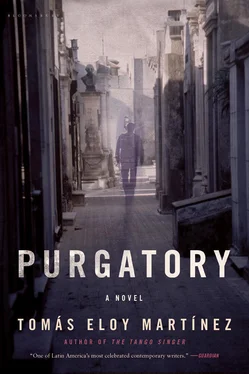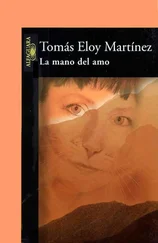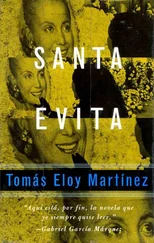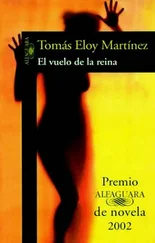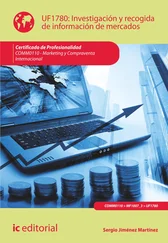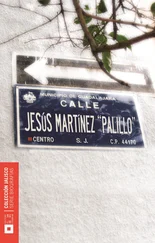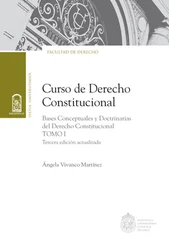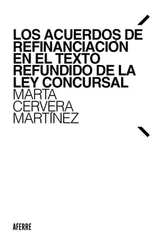Back then, anything was possible. Propaganda manufactured illusions of happiness in the wasteland of misery. Every week, magazines published eyewitness accounts of astonished gauchos who had seen fleets of flying saucers in the night sky. Schoolchildren were taught the topography of Mars, Ananke, Titan, Enceladus and Ganymede with as much dedication as they had been forced to learn by heart the names of the rivers of Europe and Siberia during the Second World War. The emissaries from alien planets, they were told, came in peace, took a number of human specimens to study their emotions and after some years — twenty, a hundred, no one knew how many — returned them to earth or kept them permanently in specialised zoos. A government minister had personally seen two large saucers collecting human specimens in the barren wilderness of the Valle de la Luna 10. The alien crew, he said, were small creatures with large heads ringed with a halo of light that seemed to protect them from our oxygenated atmosphere. With benign expressions, they were herding some twenty people they had undoubtedly collected in the cities into their spaceships. They invited the minister to join the expedition but he explained that his governmental responsibilities made it impossible. This account, from such a solemn governmental source, dispelled the doubts of even the most sceptical. News items about flying saucers were everywhere. Voluntad , a monthly magazine, interviewed six pilots who had encountered alien fleets while at the controls. One pilot, who flew the route between Río Gallegos and Ushuaia — virtually the end of the world — had even managed to photograph two spherical objects with their spindly landing gear.
Over Christmas, Nora Balmaceda became one of the chosen. Even the hardest of hearts in the country were moved by her tale — a tale that proved infinitely more successful than her romantic novels. She had persuaded her husband, a pallid heir to ten thousand hectares in the Humid Pampa, to spend Christmas of 1976 in San Antonio de los Cobres, some four thousand metres above sea level, and then drive down to Salta to see in the new year. On 26 December, they set off in their jeep towards Las Cuevas, forty kilometres south-east, taking the steep, rocky course of Ruta 51 at a moderate speed. It took more than two hours to cover the first two-thirds of the journey. Arriving in the tiny village of Encrucijada they stopped to urinate. A milky glow of stars was stealing across the nine o’clock dusk. Not a thing was moving, not even an insect, and the silence — as Nora told the newspapers — was thick as syrup. Her husband went around the hood of the jeep while she went to pee in the shelter of the escarpment. They were heading back to their vehicle when, from nowhere, they were blinded by a dazzling light that spilled its sulphurous breath over them. Nora managed, with some difficulty, to climb back into the jeep. Through the windshield she saw tiny hairless humanoid creatures floating in a firestorm of yellow flame. Suddenly, the light was snuffed out and she was left in an inexplicable state of torpor. Perhaps she fell asleep, though only for a minute or two. When she came to, she found herself several hours’ drive away in Rosario de Lerma at the wheel of the jeep. Her husband had disappeared. The only possible explanation was that this light, by some preternatural magnetic force, had drawn him up into the heavens. Every TV channel showed the same footage: Nora, tearful, inconsolable, transfigured as she described her visions of another world. ‘There’s nothing I wouldn’t give to take my husband’s place,’ she said. ‘He has found his Shangri-La, has entered the seventh circle of paradise, he has discovered the supreme wisdom of God.’
Nora was photographed in widow’s weeds for Gente . The title of the article — in which Dr Dupuy’s hand was evident — was borrowed from Quevedo: ‘Love Constant Beyond Death’. Through her lawyers, Nora declared her intention to seek control and use of her husband’s lands until he should return from space. After speedy proceedings, the courts ruled in her favour declaring the case ‘Another close encounter of the third kind’.
Spielberg’s film of the same title was causing a furore in cinemas at the time. Spielberg’s aliens communicated by means of musical notes and — unlike those at Encrucijada or the Valle de la Luna — did not abduct objects or people. But whatever the form and the language of the alien visitors, in Argentina their existence was accepted as an article of faith. On the cover of the Dimensión Desconocida , the actor Fabio Zerpa formulated a question which the priest echoed in his Sunday sermon: ‘Are we so vain as to believe we are the only children of God in the universe?’
The affair between Emilia’s father and Balmaceda had been going on for about a year at the time Bonavena was murdered. The World Cup was coming up and women — with the exception of models and strippers — completely disappeared from the news. La Balmaceda was inconsolable at being suddenly eclipsed by virtue of being a widow and because of her lack of interest in the military junta. Her last novel had been published in 1974 and she was not writing another. Early in June, shortly before the start of the World Cup, she made another bid for fame, publishing an article in the Somos offering to ‘motivate’ — this was the word she used — the Argentinian players in the changing rooms and the gyms where they trained. The article, entitled ‘Country Comes First’ made her a laughing stock. Emilia’s father felt so humiliated by his lover’s blunder that he stopped taking her calls. Balmaceda wasted little time in replacing him with a tennis champion, posing with him next to his tennis trophies for the press, and later with a ship’s captain who eventually ended up with the land that had belonged to the husband now lost in space.
She firmly resisted the mortifications of age. In photographs in Gente , day by day, month by month, it was possible to watch as her laughter lines, the bags under her eyes, the folds of her double chin, gradually disappeared; watch as her eyes became bigger, her lips fuller, as her tits and her ass defied the effects of gravity. Once the cycle was complete and she had recovered her lost youth, Nora stumbled on another profitable idea, one which once again sold thousands of books. In flights of mystical rapture she described a wrestling tournament between the angels: the seraphim who had six wings, and the cherubim who had only four. She wrote pages and pages of incomprehensible drivel (which people nonetheless reverently quoted by heart) which, she said, were dictated to her by beneficent angels lately returned from visiting God. Her greatest success came when she announced that she had witnessed an apparition of the Virgin Mary on the plains of Esteco, 1300 kilometres north-east of Buenos Aires. A prosperous city had been established there in the late sixteenth century, but by the time Nora Balmaceda drove past with a military escort in search of angels it was a barren wilderness. She had read somewhere that Esteco had been razed by the earthquake of 1692, and the winds of God’s wrath had wiped out its heathen inhabitants. On the banks of the Río Pasaje, where a six-foot menhir marks the spot of the former settlement, Nora had met a goatherd, a little girl who was visited by the Mother of God at dawn every Wednesday. The little girl told Nora that the Virgin appeared as a form without a face, a gentle voice, enfolded in a mantle of light. These visions, wrote Nora, could only be of the Blessed Virgin. ‘Our Lady has come back to this world to put an end to the brutality of atheist extremism and to redeem those who are prepared to repent.’ In her conversations with the little shepherdess, the Virgin had asked that a maximum security basilica (a basilica, not a chapel, Nora insited) be built nearby where she would personally cleanse misguided souls and guide them to heaven. The magazine in which her article was published saw its circulation triple and before the place could be overrun with penitent pilgrims, the junta dispatched sick prisoners from jails and ordered them to dig the foundations of this new temple. Two months after first meeting the little goatherd, Nora wrote that the girl had watched, overjoyed, as the prisoners ascended into heaven on a carpet of light. On a local radio station the prophet was heard to say, ‘Angels took them up to heaven.’
Читать дальше
